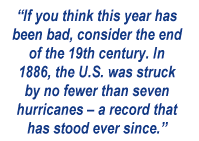
COVERING TAMPA BAY AND ITS WATERSHED |
Our subscribe page has moved! Please visit baysoundings.com/subscribe to submit your subscription request. |
|||||||
Is Global Warming Causing an Increase in Hurricanes?
The world's leading climate research institutions, such as the World Meteorological Association and the United Nation's Intergovernmental Panel on Climate Change, have said that severe weather events - heat waves, droughts, and floods - are on the rise and will continue to increase in the decades ahead. It's no wonder that in searching for the culprit behind billions of dollars in hurricane damages over the past month, many are casting suspicious glances at global warming. In searching for the cause, however, we should take time to reflect on hurricanes past. Active hurricane seasons appear frequently in historical records. If you think this year has been bad, consider the end of the 19th century. In 1886, the United States was struck by no fewer than seven hurricanes - a record that has stood ever since - and the 1890s were one of the most active decades of the past 150 years. Even Florida's recent misfortunate is not without precedent: three hurricanes struck Florida in 1926 and another three in 1964.
Since then, the United States has experienced more active hurricane seasons, except during El Nino events, which hindered hurricane formation in the Atlantic in 1997 and 2002. Hurricanes Charley, Frances, Ivan and Jeanne, despite causing billions of dollars in damage already, still represent a hurricane season that is within the bounds of natural climate variability. There is no evidence that global warming has played a part in hurricane activity up to now. Nevertheless, it's important to realize that the past is not a perfect indictor of what the future will bring. With high ocean temperatures the norm once again, the active hurricane seasons we have been experiencing recently are expected to continue for the next few decades. In addition, the growing human influence on the climate system is increasing the likelihood that future hurricane seasons will look like the one we're experiencing now. We know we are warming the world and its oceans. And we know that higher ocean temperatures favor larger hurricanes and more hurricanes reaching the United States. As global warming continues, more and more of the hurricanes making their way toward our coastlines may be category 3-5 storms rather than category 1-2 storms, and the after-effects of such big storms - intense precipitation, floods, tornadoes - will be also worse. Dealing with the widespread destruction of a category 3-5 hurricane in a highly populated area will always be difficult. However, complacency in the face of such storms increases the challenge. Development in coastal areas is booming as more people, and more wealth, are concentrated along the water's edge. This development continues under the assumption - or hope - that the next big storm will strike at another time in another place. Mother Nature has just demonstrated the dangers of such complacency, leaving us to sort out what we did wrong as we try to pick up the pieces. We can't prevent the formation of hurricanes due to natural climate variability, and it's already too late to prevent some global warming, but we can start planning accordingly. Now that hurricanes are expected to be common along U.S. coasts for years to come, we should rethink building codes, disaster management plans and funds, and public and private insurance programs to ensure we're building communities that are less vulnerable to hurricane damages rather than more.
|
||||||||
|
||||||||
|
© 2004 Bay Soundings
|
||||||||
 In the wake of Hurricanes Charley, Frances, Ivan and Jeanne, the question on everyone's tongue, particularly in Florida, is "What's going on?" Meteorologists at every news organization have provided brilliant displays of the latest weather imaging technology and talked at length about tropical waves, sea surface temperatures, and steering currents. Many sitting at home, however, are thinking about another climate phenomenon - global warming.
In the wake of Hurricanes Charley, Frances, Ivan and Jeanne, the question on everyone's tongue, particularly in Florida, is "What's going on?" Meteorologists at every news organization have provided brilliant displays of the latest weather imaging technology and talked at length about tropical waves, sea surface temperatures, and steering currents. Many sitting at home, however, are thinking about another climate phenomenon - global warming. Hurricane frequency and intensity vary over time, as a result of natural cycles in the climate system, specifically the North Atlantic Oscillation (NAO). When the NAO causes higher ocean temperatures, hurricanes tend to grow larger. Higher temperatures also influence the track of hurricanes, increasing the chance of hurricanes making landfall in the United States. Cooler ocean temperatures are associated with smaller hurricanes, with fewer reaching the United States. The most recent cool phase of the NAO ended in 1995, and with it ended a long period of low hurricane activity.
Hurricane frequency and intensity vary over time, as a result of natural cycles in the climate system, specifically the North Atlantic Oscillation (NAO). When the NAO causes higher ocean temperatures, hurricanes tend to grow larger. Higher temperatures also influence the track of hurricanes, increasing the chance of hurricanes making landfall in the United States. Cooler ocean temperatures are associated with smaller hurricanes, with fewer reaching the United States. The most recent cool phase of the NAO ended in 1995, and with it ended a long period of low hurricane activity.